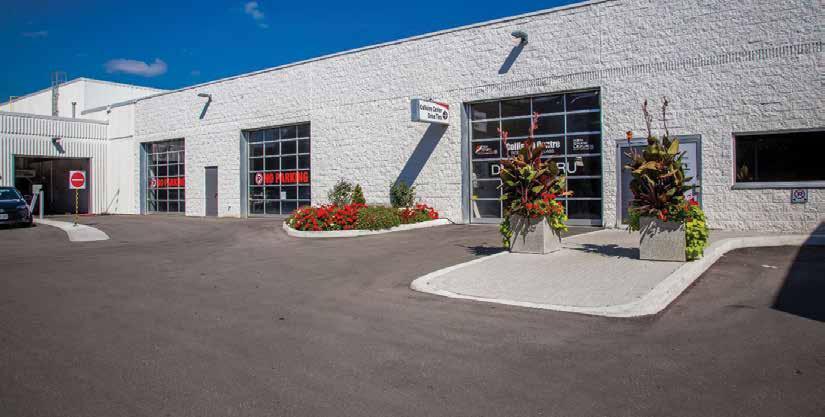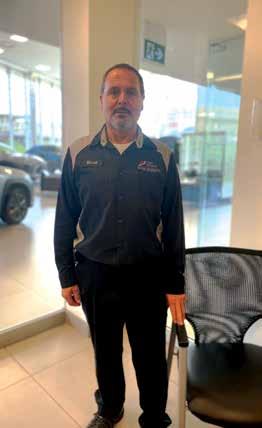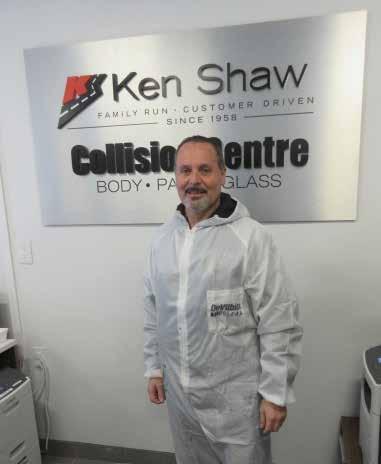
11 minute read
SKILLS
from Bodyworx 7#3
THE ART OF DELAYED GRATIFICATION
Refinishing the automobile with pride
BY STEFANO LIESSI
Way back, during a time where people paid with cheques and wrote letters of correspondence on birch bark, I used to go shopping for groceries with my mother. As a child, I hated this task, so my buy-in was the acquisition of a magazine at the checkout. A Hot Rod or Car Craft magazine—some of which I still retain to this day.
Yes, I was going to paint cars when I got older. This was a certainty, as there was absolutely nothing cooler than the flames, scallops, stripes, and candies that graced the cover of these publications monthly. This is what I wanted to do for a living, a career, to have my work on the cover of a magazine, custom painting.
Much has changed over the years in our industry. Who would have thought that the candies of yester-year could be the actual factory finish on a vehicle that you buy brand-new, and who would have thought that the pearls and metallics would have the depth and shine out the door that they do.
If one thinks back real hard, the lacquer and single stage metallics of yester-year had the depth of a tablecloth.
Now if you haven’t guessed it by now, my beginnings in refinish are dated to times when the flash off of a coat of paint was timed by having a cigarette outside the booth, mainly on the multiple “overall” or “complete” refinishes we would do. It was not uncommon to do a full paint job on a vehicle that was a family grocery getter.
My father had his ’75 Olds’ Delta 88 refinished and patched up three times over its lifespan, with each time coming home with a surface texture, and depth, that resembled citrus fruit. This, however, was deemed acceptable to the masses.
My training back then was live and on the floor. Started with prepping using lacquer primer and putty, sanding with a jitter bug sander sporting P180 on the hand numbing, chrome eating, window scratching, air-driven mechanical wonder. Masking all the trim, handles, chrome, and even the name plates—yes The expense of learning back then was minimal. Today, the skill and technical knowledge far exceeds that of “tinting by eye”. We need let down panels, we need spray out cards, we need to be 100 percent informed on what the manual and SOP from the paint manufacturer say.

name plates, my favorite being the “Park Avenue” or “Buick Electra” script, so lovingly created by the General and shared with AMC. Masking tape, no fine line, not even quarter inch at the time. Let us not forget the wonders of lacquer finish that GM flogged to the very end, not to mention the dispersion lacquer used on the Grand Nationals….
Sand it down with P400, spray some primer hoping it wouldn’t wrinkle, then bake it under the lights only to have it re-flow and come out looking like deep wet black paint, lets sand all over again. Then off into the crossflow booth with puddles of water on the floor from wetting it down to keep the dust down from the preppers sanding just inches away from the filters.
There it was, in all its glory, the “North American Land Yacht” in all its prepped beauty, ready for a coat of high-end, single stage acrylic enamel.
The test of a good painter back then was if you could spray a single stage metallic light blue without the trademark visual of tiger stripes and clouds (modeling or blotchiness). Also, could you get the center of that hood as wet and shiny as the sides, without leaning into the wet finish on the fender.
And just as you thought it was all over, there was that fly that would find its way into the fresh surface of that beautiful Olympic pool sized hood only to succumb to the fumes and
perish during it’s two foot marathon attempt at the back stroke.
Next, we would push it into the drying room to wait patiently for the cycle of time it took for the heat lamps to dry the finish to that satiny hazed glow known to many as a single stage metallic.
Remember the “spot repair” back then, mixing cocktails with a smoke in your mouth, dipping the stir stick into the can knowing that if all else fails for colour, just add some green, fixes everything. Tinting by eye, little bit of this, little bit of that, cocktail the reducers and (if it had any) hardener, using RM with Ditzler, or DuPont, if things were out of stock—good enough to rock and roll!
Do you have a clear picture of what once was? You young ladies and gentlemen of the trade are fortunate enough not to experience that remarkable wonder in time, coupled with the transition of plastics and two stage products? Oh, what a time it was.
Fast forward to today. Beautiful colour pallets with tri-stage, quad stage, pearls, and matte finishes. I spent decades on getting that “wet look” out of the booth…and now people want matte, go figure. However, that aside, matte finishes present their own set of challenges.
So why the trip down memory lane? Times are changing, training and development are changing. Back in the day, we didn’t have paint manufacturer-based training, our suppliers dropped off product and chatted with us, showed us the new goods, the rest we figured out.
This all comes at a cost, not to mention the cost of materials. At more than $400 for a gallon of hardener, you no longer can “cocktail something”. Over my years I was able to hone my craft quite well. I could lay a “splash” with the best of them, never made a magazine cover, but did do many a show finish.
The point here is, that was then and this is now. With the refinish role what it is, and the actual fact you only get one shot at it each time (redo’s will destroy your profit margin), and you can’t “bury” it (never could really, defies scientific logic) it is very wise as a business to be aware of the cost involved with each colour, as they vary considerably across the rainbow. Be fully aware of the actual time required for your painter and prepper to get that vehicle through the cycle. If you’re forgetting the tri or quad extra, let down panel time, dee nib and finesse—remember the fly… they are still out there—then you are doing a disservice to your staff and business.
In my opinion, and you are entitled to my opinion, delayed gratification of a fine refinish job is one of the best forms of advertising out there for your shop. If you want to spend money on advertising, spend it on your paint department. What better place than an actual subliminal rolling billboard backed by a vocal presenter, your satisfied customer.
As a Red Seal technician and the founder of Canadian Collision Specialist, Stefano enhances his experience with 12 years of I-CAR instructing coupled with high school teaching to bring you training that encompasses all learning types. Having experienced the corporate side of the industry, along with management and ownership, Stefanos focus is, getting it right the first time with proper repairs, equitably, for all the people involved in the collision industry. Times are changing, training and development are changing. Back in the day, we didn’t have paint manufactured based training, our suppliers dropped off product and chatted with us, showed us the new goods, the rest we figured out.


A paint booth of yester-year.

Coatings that once had the depth of a tablecloth have transformed into beautiful colour pallets with tri-stage, quad-stage, pearls and mattes.
THE DEDICATED PAINTER
37 years and nearly 40,000 cars later

BY SOPHIE PRICE
Passion will get you far in this trade. If you’re skeptical, Vince Figliomeni can prove it.
Vince has been a painter at Ken Shaw Lexus Toyota Collision for 37 years. In that time, the dedicated painter has returned approximately 38,480 vehicles to their pre-accident glory.
Vince first joined the automotive industry in his home country of Italy, where he got his start at working alongside his cousin in a local bodyshop. After arriving in Canada, armed with limited English and an outpouring
of passion for the trade, Vince’s wife assisted in his job search, which ended at Ken Shaw Lexus Toyota.
He began as a prepper in 1983, and after roughly a year his manager suggested he make the leap to painter. “I was so nervous to start because I knew it was a dealership and I had never worked in that large of a setting,” said Vince. “It was a big place, but I took a chance,” he said.
Vince says that at first, he was “more scared than enthusiastic,” but his confidence grew as his colleagues applauded his work and his managers took note of his skill.
“Guys would actually look into my job and they were kind of impressed and would say ‘oh my god his paint job is pretty good,’” laughed Vince. “It was a real motivator.”
As the facility’s only painter, Vince saw his skill grow alongside experience, but Ken Shaw Lexus Toyota has also supported him for training over the years to further improve his skills.
To this day, Vince is still the main painter at Ken Shaw Lexus Toyota Collision with only one other person assisting him on the odd occasions.
Vince is an advocate for the trade and says painting cars isn’t as simple as it sounds.
“Spraying cars is the easy part. Then you have to have knowledge of the preparation and how to make sure it is done properly; you have to know some bodywork, and there’s a ton of work involved tinting colours. Sometimes colours aren’t always matching properly so you always have to double and triple-check to make sure you put the right colour on the car”.
After staying at Ken Shaw for 37 years, Vince can’t imagine himself working anywhere else.
“They treat people well,” he says. “Not
Vince is also the most senior employee at Ken Shaw Toyota. Danny Jamal, general manager at Ken Shaw Lexus Toyota says the other employees call him “Papa Vince” and turn to him for any advice in the bodyshop, or elsewhere.

Vince Figliomeni, the senior painter at Ken Shaw Lexus Toyota Collision, has painted approximately 38,000 cars in his 37-year career.


Vince’s work is of such a high caliber; Danny Jamal says he’s never seen a customer come back to complain.

“His work is as quality as the day it comes out of the factory. He is flawless, like perfection. We wish we could genetically clone him.” – Danny Jamal, general manager, Ken Shaw Toyota
just me but the rest of the employees here. I know they’ll always make sure I have the right equipment, and we have everything we need.”
Vince’s commitment to his work is very clear, he takes pride in what he does and works hard to please his employers.
“I am prouder of what I do when there’s appreciation, and I am sure it goes both ways. Them seeing that I do well for them and me being happy with the way they treat me—it’s what motivates me.”
Vince is also one of the longest-standing employees at Ken Shaw Lexus Toyota Collision. Danny Jamal, general manager at Ken Shaw says the other employees call him “Papa Vince” and turn to him for any advice in the bodyshop, or elsewhere.
“He has been around longer than all of us, he’s smarter than all of us and he has more wisdom than all of us. So, we all come to him for help and advice” says Jamal.
Vince says that the most important thing to him is admitting when you are wrong or when you make a mistake and trying to learn from it. He makes it very clear that every day is still a challenge, from the new colours constantly being released to learning how to properly spray those colours can take time and effort. Still, he takes each problem as a challenge and says the constantly changing environment helps to challenge and motivate him.
When asked about his proudest moment Vince says he feels proudest when his superiors are with happy with his job.
“When they tell me ‘good job Vince’. I feel great about that.”
Not only has Vince painted roughly 38,480 cars in his career but he has a receipt for every single car he has ever painted at Ken Shaw Lexus Toyota.
Jamal speaks very highly of Vince.
“He’s a great guy. He always comes to work happy and productive and ready to work. He is very professional with the other employees, management and owners.”
The general manager says it’s rare for the facility to see a vehicle come back with a paint issue. In his own 11 years at the company, he can’t remember the last time a vehicle came back with a paint problem.
“His work is as quality as the day it comes out of the factory. He is flawless, like perfection.” adds Jamal. “We wish we could genetically clone him.”







